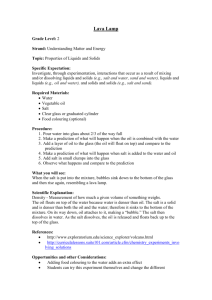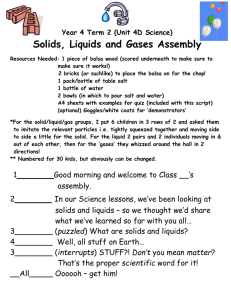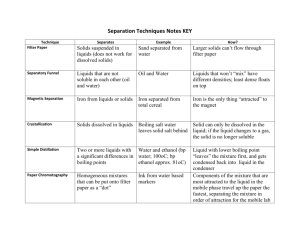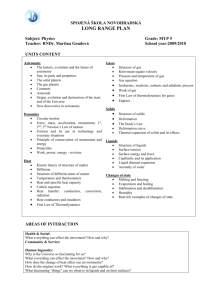SCHEME OF WORK FOR Y5 SCIENCE TOPIC:
advertisement
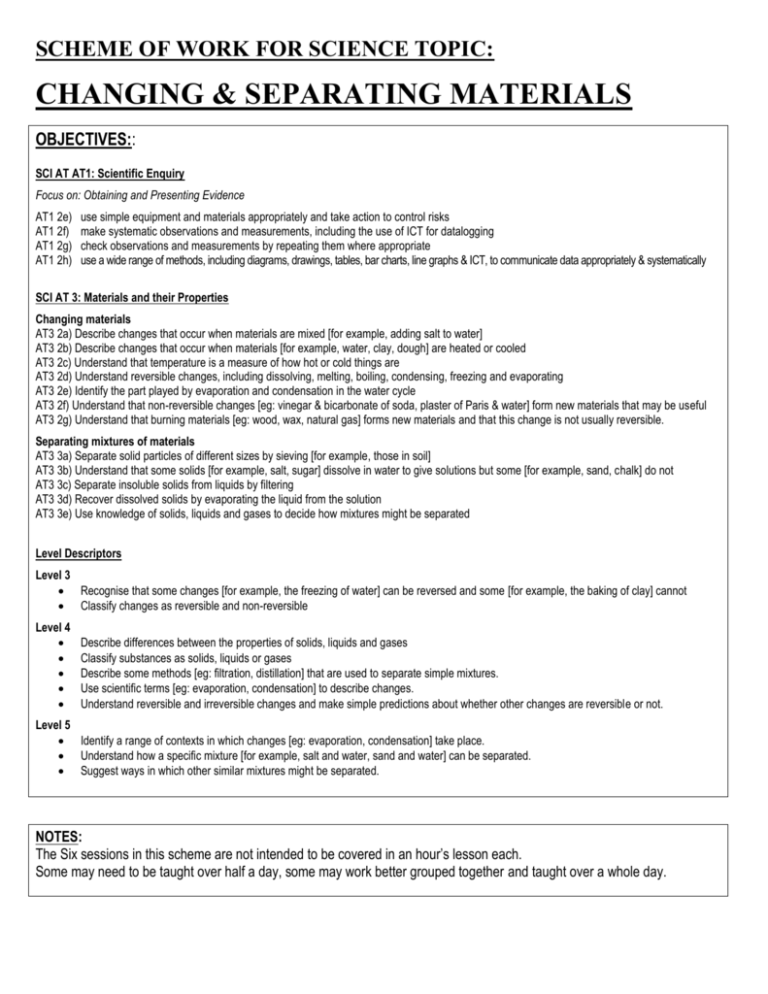
SCHEME OF WORK FOR SCIENCE TOPIC: CHANGING & SEPARATING MATERIALS OBJECTIVES:: SCI AT AT1: Scientific Enquiry Focus on: Obtaining and Presenting Evidence AT1 2e) AT1 2f) AT1 2g) AT1 2h) use simple equipment and materials appropriately and take action to control risks make systematic observations and measurements, including the use of ICT for datalogging check observations and measurements by repeating them where appropriate use a wide range of methods, including diagrams, drawings, tables, bar charts, line graphs & ICT, to communicate data appropriately & systematically SCI AT 3: Materials and their Properties Changing materials AT3 2a) Describe changes that occur when materials are mixed [for example, adding salt to water] AT3 2b) Describe changes that occur when materials [for example, water, clay, dough] are heated or cooled AT3 2c) Understand that temperature is a measure of how hot or cold things are AT3 2d) Understand reversible changes, including dissolving, melting, boiling, condensing, freezing and evaporating AT3 2e) Identify the part played by evaporation and condensation in the water cycle AT3 2f) Understand that non-reversible changes [eg: vinegar & bicarbonate of soda, plaster of Paris & water] form new materials that may be useful AT3 2g) Understand that burning materials [eg: wood, wax, natural gas] forms new materials and that this change is not usually reversible. Separating mixtures of materials AT3 3a) Separate solid particles of different sizes by sieving [for example, those in soil] AT3 3b) Understand that some solids [for example, salt, sugar] dissolve in water to give solutions but some [for example, sand, chalk] do not AT3 3c) Separate insoluble solids from liquids by filtering AT3 3d) Recover dissolved solids by evaporating the liquid from the solution AT3 3e) Use knowledge of solids, liquids and gases to decide how mixtures might be separated Level Descriptors Level 3 Recognise that some changes [for example, the freezing of water] can be reversed and some [for example, the baking of clay] cannot Classify changes as reversible and non-reversible Level 4 Describe differences between the properties of solids, liquids and gases Classify substances as solids, liquids or gases Describe some methods [eg: filtration, distillation] that are used to separate simple mixtures. Use scientific terms [eg: evaporation, condensation] to describe changes. Understand reversible and irreversible changes and make simple predictions about whether other changes are reversible or not. Level 5 Identify a range of contexts in which changes [eg: evaporation, condensation] take place. Understand how a specific mixture [for example, salt and water, sand and water] can be separated. Suggest ways in which other similar mixtures might be separated. NOTES: The Six sessions in this scheme are not intended to be covered in an hour’s lesson each. Some may need to be taught over half a day, some may work better grouped together and taught over a whole day. ACTIVITY SESSION 1 SOLIDS, LIQUIDS & GASES. EVAPORATION & CONDENSATION: A REVERSIBLE CHANGE Objectives: AT3 2d) Understand reversible changes, including dissolving, melting, boiling, condensing, freezing & evaporating AT3 2e) Identify the part played by evaporation and condensation in the water cycle AT1 2e) use simple equipment and materials appropriately and take action to control risks 1) Recap the properties of: Solids, Liquids and Gases - Look at “Solids, Liquids & Gases” PowerPoint of the different states of matter - - Solids – molecules held together with strong bonds - they don’t move very easily; maintain own shape & volume - Liquids – molecules have weaker bonds - can move around slightly; can flow; can’t maintain shape unless in a container - Gases – Molecules are free to move around; can spread around an open space quickly and freely; can’t keep their shape unless they are kept in a sealed container. Look at http://www.bgfl.org/bgfl/custom/resources_ftp/client_ftp/ks3/science/changing_matter/index.htm to see how ice (solid) can be melted into water (liquid) and boiled to make a gas (water vapour) Look how molecules are moving and how the bonds between them change in each state Note: water is a special substance on this planet as it can easily exist as solid, liquid & gas - Get a group of children to stand up and ‘act out’ these changes of state. Stand huddled together for a solid. Heat them up, they begin to wander in and out of each other as a liquid, (kept in place by a circle of children as the ‘container’). Heat them further and they become a ‘gas’ & run ‘freely’ round room (What would happen if we opened the door?!) 2) SAFETY: Demonstrate boiling a kettle (set up near a cold window) to turn water to water vapour. What happens to water when you boil it? (The water molecules get given so much energy they move about much more quickly and some molecules ‘break free’ from the liquid and escape into the air as a gas – water vapour. This is called evaporation. 3) Spray some perfume into a Petri dish, note it begins as a liquid and soon ‘disappears’ (evaporates). In perfume this evaporation is speeded up by using ethanol in the mixture. 4) Look again at “Solids, Liquids & Gases” PowerPoint, and continue slides to examine changes which happen at each stage of the process of heating/evaporating ice/water. (NB: can the children remember the term ‘evaporates’ before being given it?) ICE Heat (melts) WATER Heat (evaporates) Water Vapour / Steam 5) Continue “Solids, Liquids & Gases” PowerPoint - look at chilled coke can. How have droplets of water got on the outside? (Condensation happens when warm water vapour in the air meets a cold surface, which cools the vapour down turning it back into a liquid, so droplets of water form on the cold can. This is like condensation on a cold window when water vapour from your hot breath condenses into droplets of water on the window) 6) Give children chilled mirrors to breathe on, to condense water vapour from their breath. 7) Look at boiling kettle next to cold window. Observe process of evaporation condensation and conclude: gaseous water vapour can be turned back into liquid water through ‘condensation’ 8) Continue looking at slide 3 “Solids, Liquids & Gases” PowerPoint to show the reversal of ‘evaporation’ is ‘condensation’ … WATER Cool (condenses) Water Vapour / Steam 9) Ask: how do I turn the water (liquid) back into a solid… Complete the process on PowerPoint Presentation … ICE Cool (freezes) WATER * Because this change can go both ways and be ‘reversed’ we call it a ‘reversible change.’ (Look at how the arrows on the PowerPoint Presentation go ‘both ways’. Trace the change backwards and forwards to confirm the reversible nature of this change. 10) In small groups, children set up jam jars of warm/hot water and stretch cling film over the top. Then place a bag of ice cubes on top of the cling film. The hot water evaporates, then cools and condenses on the cold surface of the cling film. [Continued . . .] RESOURCES * “Solids, Liquids & Gases” PowerPoint (showing molecular bonds of each state and an explanation; ICE Heat (melts) WATER Heat (evaporates) Water Vapour / Steam) * Web link http://www.bgfl.org/bgfl/custom/resources_ftp/ client_ftp/ks3/science/changing_matter/index.htm * Kettle to boil water near cold window (SAFETY) * Perfume / aftershave * Petri dish * Chilled mirrors * Evaporation and Condensation Experiment sheet * jam jars of hot water (SAFETY) * Cling film * Ice cubes in sealed plastic bags * ice cube rack * Other web links: http://www.fossweb.com/modulesK2/SolidsandLiquids/activities/changeit.html http://www.bbc.co.uk/schools/ks2bitesize/ science/activities/gases_fs.shtml 11) Record experiment and use the words ‘evaporate’ and ‘condensate’ on their sheets Plenary: 12) Look at animation of “The Water Cycle” and the parts played by ‘evaporation’ and ‘condensation’ in the process (Resource from Crick Web) http://www.crickweb.co.uk/assets/resources/flash.php?&file=changingstate (Click the orange ‘Menu’ button and then select “The water Cycle”) SESSION 2 DISSOLVING: CLASSIFYING SOLUBLE AND INSOLUBLE SOLIDS Objectives AT3 2a) Describe changes that occur when materials are mixed [for example, adding salt to water] AT3 2d) Understand reversible changes, including dissolving, melting, boiling, condensing, freezing & evaporating AT3 3b) Understand: some solids [salt, sugar] dissolve in water to give solutions but some [sand, chalk]do not AT1 2h) Use a wide range of methods, including tables to communicate data appropriately & systematically 1) What can children remember about solids liquids & gases from last lesson? Use ABPI site http://www.abpischools.org.uk/page/modules/solids-liquids-gases/slg2.cfm?age=Age%20Range%207-11&subject=Science (Button 8 along bottom) 2) Ask: What is water? (Liquid) What is salt? (Solid – even though we can ‘pour’ it!) 3) (a)What will happen when we put a spoonful of salt into a beaker with 200ml of water? Demonstrate this to children. Explain that the salt has ‘dissolved’ (the grains (crystals) of salt have broken up and spread out within the water so you can’t ‘see’ the grains of salt (crystals) anymore – but they’re still there) (b) Because salt (a solid) dissolves we say that it is a soluble solid. Explain that ‘soluble’ means ‘will dissolve’. The salty water is called ‘salt solution’. (In the same way you can produce: ‘sugar solution’, ‘coffee solution’ and ‘gravy solution’) 4) (a) What will happen when we put a spoonful of sawdust into a beaker with 200ml of water? Demonstrate this to children. Explain that the sawdust has not dissolved – you can still see it there, floating on the top of the water. (b) Because sawdust (a solid) does not dissolve, we say that it is an insoluble solid. Explain that ‘insoluble’ means ‘will not dissolve’. 5) (a) What will happen when we put a spoonful of powder paint into a beaker with 200ml of water? Demonstrate this to children. Explain that the powder paint has not dissolved – you can’t see the powder anymore, but the particles have spread out and can still be seen ‘hanging about’, spread out throughout the water making it change colour and viscosity. (b) Because the particles of powder paint ‘hang about’ in this way, it’s called a suspension, these particles of powder paint have not dissolved and will eventually settle out to the bottom of the container. 6) Explain that in small groups, the children will be given a range of solids to test whether they are soluble or insoluble. (Decide how you will keep the test fair; discuss the variables to remain constant: amount of water, temperature of water, amount of solid added etc.) 7) In groups, children firstly predict, then test whether the following solids are soluble or not. Record predictions and findings on sheet. Classify the solids as soluble or insoluble. (Solids to test in water: sand, chalk, sugar, flour, coffee granules, rice, gravy granules) Plenary 8) Share findings. Which solids were soluble (sugar, coffee, gravy) and which were insoluble (sand, chalk, flour, rice). Explain that although the chalk & flour made the water go cloudy, you could still see the particles which had not dissolved (or hear them scraping as you stirred) as they did not actually dissolve. If you left them for a while the chalk and flour would settle out and fall to the bottom of the container again. The cloudiness you can see is called a ‘suspension’ – if the particles are suspended, they are not dissolved. 9) Visit ABPI site http://www.abpischools.org.uk/page/modules/solids-liquids-gases/slg2.cfm?age=Age%20Range%20711&subject=Science (click button 5 along bottom) * 7 beakers / plastic cups per group * Beaker to measure water per group * Jug to hold water per group * plastic spoons * sawdust * salt * sand * chalk * sugar * flour * coffee * rice * gravy granules * powder paint (teacher demo only) * Jam jars (teacher demos) * “Dissolving Experiment” sheet SESSION 3 REVERSIBLE & NON-REVERSIBLE REACTIONS (BURNING, HEATING & CHEMICAL REACTIONS) Objectives AT3 2b) Describe changes that occur when materials [for example, water, clay, dough] are heated or cooled AT3 2g) Understand that burning materials [eg: wood, wax, natural gas] forms new materials and that this change is not usually reversible. AT3 2f) Understand that non-reversible changes [eg: vinegar & bicarbonate of soda, plaster of Paris & water] form new materials that may be useful AT1 2e) use simple equipment and materials appropriately and take action to control risks (tea lights) * Recap processes of melting & evaporating; then condensing & freezing ice / water / vapour (Look back at PowerPoint). As this change can go ‘both ways’ we call it a reversible change) Burning * Explain: not all changes are reversible. Examine match with children. Note wood splint and Phosphorus-based (highly combustible) head. Strike match, allow it to burn. Note heat, light & sound produced. Blow out flame – note smoke is produced. Examine burnt match – the new material produced is soot (carbon). Can match be turned back to how it was to start with? No; so we say this is a non-reversible change (also called an irreversible change). Note: some useful things can be produced in non-reversible changes (reactions) – eg heat & light from burning match * Is burning paper reversible or non-reversible? Demo. burning a small piece of paper, held in wooden clothes peg, over a tea light. Allow burnt ash to fall onto metal tray. Examine ash compare with unburnt piece of paper. Conclude: burning is a non-reversible change. (Also same for gas burnt on a stove & wax burnt by a candle – melted wax however can be reversed) Heating * Explain: ‘heating’ is a less severe process & can produce reversible & non-reversible changes * Explain: we’re going to predict & test whether a reversible change will occur when different materials are heated over tea lights. (Test: butter, grated chocolate, grated wax, grated cheese, egg, plasticine) Split children into 5 groups, each testing a different material, except plasticine. (Teacher should heat a small disc of plasticine, as this needs to be left quite a few minutes before the non-reversible change takes place). Discuss safety issues. Discuss how to keep test fair use same quantities. Place substance in foil dish over tea light. As they melt, keep a class record of how long each one takes. Once it has been heated, examine & describe its appearance on sheet – how has it changed? Leave foil dishes to cool, to see if the process can be reversed. (This cooling may take a while so the next section of the lesson will give time for this to happen) Non-reversible Chemical reactions * Gather class together. Demonstrate mixing substances together to create non-reversible chemical reactions. Explain: these reactions produce new materials which can sometimes be useful - in some, heat is given off. Mix substances in test tubes. Observe reaction. (Fix a small balloon over top of test tube to observe the effect of the carbon dioxide gas given off, which is the same gas in ‘fizzy drinks’, and the same as the waste gas we give off when breathing). - bicarbonate of soda + lemon juice (endothermic reaction) - dried yeast + sugar solution - Alka-Seltzer + vinegar (Also: Use camera film pot of water, drop in tablet, quickly replace lid, stand on tray & watch it launch!) - plaster of Paris + water (exothermic reaction) [SAFETY] (use a disposable pot) Note: whenever a gas is given off in a reaction, then a chemical reaction has taken place & this is always non-reversible. Heating – conclusions * Examine cooled substances in foil pots. What type of change took place during the melting/ cooling processes? (Substance back to how it was before = reversible change; substance altered & different to how it was before = non-reversible change). Record findings on sheet Plenary Reversible Changes grated cheese, grated wax , grated chocolate, butter Non-Reversible Changes plasticine, egg * Visit http://www.abpischools.org.uk/page/modules/solids-liquids-gases/slg2.cfm?age=Age%20Range%207-11&subject=Science (Click button 11 along bottom) * Visit: BBC Sci Clips http://www.bbc.co.uk/schools/ks2bitesize/science/activities/solids_liquids.shtml * “Solids, Liquids & Gases” PwrPoint * Matches (SAFETY) * PowerPoint picture of burnt match * Small pieces of paper * Metal tray * Tea lights * Candle stands * Sand trays & sand * Wooden splints for lighting candles * Wooden clothes pegs glued to strips of square dowel * Small samples (kept cool) of: * butter * grated wax * grated chocolate * plasticine * grated cheese * egg * Stopwatch * “Heating Materials Experiment” sheet * Bowl of cold water * test tubes * test tube rack * small modelling balloons * bicarbonate of soda * lemon juice * dried yeast * sugar solution * Alka-Seltzer * vinegar * plaster of Paris * camera film pot * Web links: - http://www.abpischools.org.uk/resources/ solids-liquids-gases/slg2.asp - http://www.bbc.co.uk/schools/ks2bitesize/ science/activities/solids_liquids.shtml Note: (from ABPI) In a chemical change, the bonds between the particles of the substances are broken and reform in a different arrangement as a new substance. This may require energy taken from the surrounding material, and there is a drop in temperature as happens when lemon juice and bicarbonate of soda are mixed. Very often however, there is energy produced as a result of the reaction and an increase in temperature, as in the reaction between Plaster of Paris and water. SESSION 4 DISSOLVING: INVESTIGATING SATURATION & EFFECT OF WATER TEMPERATURE Objectives AT3 2a) Describe changes that occur when materials are mixed [for example, adding salt to water] AT3 2c) Understand that temperature is a measure of how hot or cold things are AT1 2f) make systematic observations and measurements AT1 2g) check observations and measurements by repeating them where appropriate AT1 2h) use diagrams, tables, line graphs & ICT, to communicate data appropriately & systematically AT1 2i) make comparisons of their own observations and measurements AT1 2j) use observations, measurements to draw conclusions PART ONE: SATURATION * Demonstrate dissolving a spoonful of salt into a jar of water. * ASK: What has happened to the salt? (Dissolved) What is the liquid now called? (salt solution). What would happen if I added another spoonful of salt? (dissolve) But what would happen if I kept on adding spoonfuls of salt…? * EXPLAIN: that eventually the water would reach saturation point and wouldn’t be able to dissolve any more salt. We say the water is saturated. You can tell when this has happened because you can see some grains of salt still present at the bottom of the jar after you have given it a stir. * INVESTIGATION: Which substance will reach saturation point quicker: salt or sugar? - Explain that children will be working in small groups to investigate this question. - Discuss fair testing and factors to keep the same (same sized jars, same amount and temperature of water, same sized spoonful each time…) - Children put 100ml of water into two jars, add a spoonful of salt to one and sugar to the other and give them a stir. Then repeat until each has reached saturation point. Record results in a table. Draw conclusions from the investigation and relate findings to results. (Sugar becomes saturated at approx 6 spoonfuls, salt at approx 3) PART TWO: EFFECT OF WATER TEMPERATURE ON SPEED OF DISSOLVING * INVESTIGATION: How does the temperature of the water effect how fast sugar dissolves? - Ask children if they think the temperature of the water makes any difference when dissolving sugar. Can they predict whether cold, warm or hot water will make sugar dissolve faster? - Explain: children are to test three temperatures of water: cold (from fridge), warm (room temp) and hot (from hot tap). How can we accurately measure how hot each is before we begin testing? (use thermometer). Remind children that the thermometer measures temperature. What is temperature a measure of? (how hot or cold something is) - They should add three spoonfuls of sugar to each jar of water at a time, start a stopwatch and stir gently. Stop the stopwatch as soon as all the sugar is dissolved. Repeat each test to ‘check’ results. Record results in a table of ‘temperature’ and ‘time to dissolve’ for each of the three water temperatures tested, twice for each temperature. * Share results and draw conclusions. Insist that the children use ‘comparators’ (~er words) to describe their results (eg: the hotter the water to quicker/faster the sugar dissolved; the colder the water, the slower the sugar dissolved) * Demonstrate to the class how this data could be presented as a line graph: ‘temperature’ along the x axis and ‘time to dissolve’ up the y axis. Explain that because both temperature and time are what’s called ‘continuous’ data, we can use it to draw a line graph. We can also use the finished line graph to work out how long the sugar would have taken to dissolve at temperatures other than the ones we actually tested by ‘extrapolating’ the graph * Children draw own line graphs of the data on squared paper. They could then quiz one another to extrapolate how long it would have taken sugar to dissolve at other temperatures. * ICT: If available, spreadsheet or graphing software could be used to graph the data. * Jam jars (SAFETY) * Plastic Spoons * Salt * Sugar * beakers to measure 100ml of water * ‘Saturation Investigation’ sheet * Thermometers * 3 large containers of water (cold, warm, hot) for children to fill beakers from * Stopwatches * ‘Water temperature & Dissolving Investigation’ sheet SESSION 5 SEPARATING MATERIALS: SIEVING, FILTERING, DECANTING, MAGNETISM, EVAPORATION Objectives AT3 3a) Separate solid particles of different sizes by sieving [for example, those in soil] AT3 3c) Separate insoluble solids from liquids by filtering AT3 3d) Recover dissolved solids by evaporating the liquid from the solution * Explain that we are going to use different techniques to separate mixtures of materials. * SIEVING: How can I separate a mixture of sand & gravel? (Ask a child to demonstrate using the sieve to separate the mixture) Conclude that sieving separates different sized solids. * FILTERING: how can I separate a mixture of sawdust and water? (Ask a child to demonstrate using the filter paper and funnel to separate the mixture) Conclude that filtering separates insoluble solids from liquids * DECANTING: how can I separate a mixture of oil and water? (Teacher demonstrates how the less dense (lighter) oil, which floats on the top of the water, can be poured off leaving the water behind) Conclude that decanting can be used to separate two liquids which have different densities/weights * MAGNETISM: how can I separate a mixture of sand and paper clips? (Ask a child to demonstrate using the magnet to separate the mixture) Conclude that magnetism separates magnetic metals (iron and steel) from other materials. * EVAPORATION & CONDENSATION: how can I separate a mixture of salt and water? (Ask a child to make a strong salt solution. Pour a little into a foil dish. Heat over a tea light. Evaporate the water to leave salt crystals in the foil dish and condense the water vapour on a chilled mirror held over the foil dish) Conclude that evaporating and then condensing can be used to separate liquids from soluble solids. * EXPERIMENTS - Explain that children need to match up the correct term with its definition on their sheet - Next, get the materials indicated on the sheet and mix them together in containers - Then choose the correct separation technique to separate each mixture. (NB: Evaporation – children will place Petri dishes of dissolved materials on window sill to evaporate rather than using tea lights in this session, as there will be more movement of children around the room) - The mixtures to be made and separated are - rice + pasta shapes (sieving – use a riddle) - paper clips + sawdust (magnetism) - salt + water (evaporation) - flour + rice (sieving – use a kitchen sieve) - sugar + water (evaporation) - sand + water (filtering) Extension: * Each group makes a solution of the following materials and place these in Petri dishes on window sill to investigate what the crystals will look like when the water is evaporated away: coffee granules; gravy granules; washing powder; ‘Chromium Potassium Sulphate’; ‘Iron (II) Sulphate’; and ‘Copper (II) Sulphate’ [SAFETY: avoid hand contact with the last 4 items and ensure children have washed hands thoroughly after completing experiment.] Plenary: * Visit - http://www.bbc.co.uk/schools/ks2bitesize/science/activities/reversible_irreversible_fs.shtml (summary) * Visit - http://www.abpischools.org.uk/page/modules/solids-liquids-gases/slg2.cfm?age=Age%20Range%207-11&subject=Science (click button 10 along bottom) * Visit - http://www.e4s.org.uk/director/dissolve.htm (evaporation) * Visit - http://www.industry-animated.org/filterpress.htm (filtering) * Sieves * Riddles * Filter papers * Filter Funnels * Beakers * Jug for water & oil mixture * Magnets * Spoons * Sand * Gravel * Sawdust * Cooking oil * Paper clips * Salt * Tea light & stand, sand tray, foil dish, match, splint (1 set for teacher) * Chilled mirror * Clamp & stand to hold mirror over foil dish. * Rice * Pasta shapes * Flour * Rice * Sugar * ‘Separating mixtures’ sheet * coffee granules * gravy granules * washing powder * ‘Chromium Potassium Sulphate’ * ‘Iron (II) Sulphate’ * ‘Copper (II) Sulphate’ SESSION 6 SUMMATIVE INVESTIGATION: WHAT A MESS! Objective AT3 3e) Use knowledge of solids, liquids and gases to decide how mixtures might be separated AT1 2e) use simple equipment and materials appropriately and take action to control risks AT1 2f) make systematic observations and measurements AT1 2h) use a wide range of methods, including diagrams, drawings and tables, to communicate data systematically * INTRODUCTION: - Ask the children how I could separate a mixture of the following and demonstrate the processes to the class. (For evaporation – leave in Petri dish on window sill) - Marbles + sand + paper clips (Magnetism to separate the paper clips, Sieve to remove the marbles, from the sand) - Gravel + sand + water (Sieve to remove the gravel, Filter to separate sand from water) - Salt + Sawdust * Marbles * Sand * Paper clips * Gravel * Salt * Sawdust * Sugar * Lego blocks * A prepared mixture of mixture of: salt + sawdust + paper clips + gravel * Sieves & riddles * Filter paper * Filter Funnels * Beakers * Petri Dishes * Spoons * Magnets (Dissolve, Filter to remove sawdust, Evaporate to retrieve salt) - Sand + Sugar + Lego (Sieve to remove Lego, Dissolve, Filter to remove sand, Evaporate to retrieve sugar) - Conclude: sometimes you have to use a series of techniques to separate different materials * ‘What A Mess’ Investigation sheet * ‘What I Know About Changing and Separating Materials’ sheet * Crystals from last session * Intel PC Microscope & PC * SUMMATIVE INVESTIGATION: - Show children a bowl containing a mixture of: salt + sawdust + paper clips + gravel - Introduce the context for the investigation: Mr OoopsiDaisy was unloading some deliveries at his shop when he tripped and fell. Unfortunately he dropped some of the deliveries on the floor and they got mixed up. He swept up what he could and put it in a bucket. Can you help him separate the different materials again? - Children work in small groups to plan the separation techniques they will carry out, using the “What A Mess” sheet. Then they will use the planned sequence of separation techniques to separate the mixture. - Share results. Have children been able to separate the materials with a degree of accuracy and precision? What was difficult about the investigation? Did the children get the separation processes in the correct order… 1. Magnets to remove paper clips * 2. Sieving to remove gravel * 3. Dissolving & Filtering to remove sawdust 4. Evaporation to remove water from salt. (* These two processes could be done in any order) Plenary: * What have the children learnt about changing and separating materials in this topic? Ask them to draw a ‘Memory Map’ of everything they can remember (Assessment Opportunity) * ICT: Examine crystals formed from evaporated solutions made last session. Use Intel PC Microscope to view them at magnification, copy and print images to glue into books. WEB LINKS FOR CHANGING AND SEPARATING MATERIALS SCHEME OF WORK: SESSION 1: http://www.bgfl.org/bgfl/custom/resources_ftp/client_ftp/ks3/science/changing_matter/index.htm http://www.crickweb.co.uk/assets/resources/flash.php?&file=changingstate (Click the orange ‘Menu’ button and then select “The water Cycle”) Additional links: http://www.fossweb.com/modulesK-2/SolidsandLiquids/activities/changeit.html http://www.bbc.co.uk/schools/ks2bitesize/science/activities/gases_fs.shtml SESSION 2: http://www.abpischools.org.uk/page/modules/solids-liquids-gases/slg2.cfm?age=Age%20Range%207-11&subject=Science (Button 8 along bottom) http://www.abpischools.org.uk/page/modules/solids-liquids-gases/slg2.cfm?age=Age%20Range%207-11&subject=Science (click button 5 along bottom) SESSION 3: http://www.abpischools.org.uk/page/modules/solids-liquids-gases/slg2.cfm?age=Age%20Range%207-11&subject=Science (Click button 11 along bottom) http://www.bbc.co.uk/schools/ks2bitesize/science/activities/solids_liquids.shtml SESSION 4: (None) SESSION 5: http://www.bbc.co.uk/schools/ks2bitesize/science/activities/reversible_irreversible_fs.shtml (summary) http://www.abpischools.org.uk/page/modules/solids-liquids-gases/slg2.cfm?age=Age%20Range%207-11&subject=Science (click button 10 along bottom) http://www.e4s.org.uk/director/dissolve.htm (evaporation) http://www.industry-animated.org/filterpress.htm (filtering) SESSION 6: (None)

